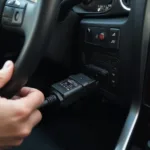A 2005 Toyota Tundra stuck in limp mode with no OBD2 codes can be a frustrating situation. You’re left with a vehicle that’s barely drivable and seemingly no way to diagnose the problem. This article will delve into the common causes, diagnostic strategies, and potential solutions for this perplexing issue, helping you get your Tundra back on the road.
Understanding Limp Mode and its Causes in a 2005 Tundra
Limp mode, also known as “fail-safe” mode, is your Tundra’s way of protecting itself from further damage when a critical system malfunction is detected. It drastically reduces engine power and limits speed to allow you to limp to a safe location. While a lack of OBD2 codes can make diagnosis tricky, there are several potential culprits for a 2005 Tundra with these symptoms. These include issues with the throttle position sensor, mass airflow sensor, transmission, or even wiring problems. A faulty ECU (Engine Control Unit) can also cause this, but is less common.
Common Causes of Limp Mode in a 2005 Tundra
- Throttle Position Sensor (TPS): A malfunctioning TPS can send incorrect signals to the ECU, leading to limp mode.
- Mass Airflow Sensor (MAF): The MAF measures the amount of air entering the engine. If it’s faulty, the engine may not receive the correct air/fuel mixture, triggering limp mode.
- Transmission Problems: Issues within the transmission, such as a failing solenoid or low fluid levels, can cause the vehicle to enter limp mode.
- Wiring Issues: Damaged or corroded wiring can disrupt communication between various sensors and the ECU, resulting in limp mode.
- ECU Malfunction: Although less frequent, a failing ECU can be the root of the problem, causing various unpredictable issues, including limp mode.
Diagnosing a 2005 Tundra Stuck in Limp Mode with No OBD2 Codes
When your 2005 Tundra is in limp mode and your OBD2 scanner isn’t showing any codes, it’s time to get creative with your diagnostics. Don’t despair; there are several ways to pinpoint the issue.
Checking for Mechanical Issues
A thorough visual inspection of the engine bay is a great starting point. Look for any loose or disconnected wiring, vacuum leaks, or signs of damage to sensors and components. Checking the transmission fluid level and condition is also crucial.
Using a Multimeter for Diagnostics
Even without OBD2 codes, a multimeter can be invaluable. You can use it to test the voltage and resistance of various sensors, such as the TPS and MAF, to determine if they’re functioning correctly.
Consulting a Professional Mechanic
If your DIY efforts are unsuccessful, consulting a qualified mechanic experienced with Toyota Tundras is highly recommended. They have specialized tools and knowledge to diagnose complex issues.
Potential Solutions for a 2005 Tundra in Limp Mode
Once you’ve identified the underlying cause of the limp mode, it’s time to address the issue. This might involve replacing faulty sensors, repairing damaged wiring, or addressing transmission problems.
Replacing Faulty Sensors
Replacing a faulty TPS or MAF sensor is often a straightforward process. These sensors are relatively inexpensive and readily available.
Repairing Wiring Issues
If damaged wiring is the culprit, repairing or replacing the affected wires can resolve the problem.
Addressing Transmission Problems
Transmission issues may require more extensive repairs, such as rebuilding or replacing the transmission, depending on the severity of the problem.
“In my experience, a surprisingly common cause of limp mode with no OBD2 codes in these Tundras is a corroded ground wire near the transmission. It’s often overlooked during initial inspections,” says John Miller, ASE Certified Master Technician.
Conclusion
A 2005 Tundra stuck in limp mode with no OBD2 codes can be a challenging problem, but with a systematic approach to diagnosis and repair, you can get your truck back on the road. Remember, starting with a thorough visual inspection, utilizing a multimeter, and consulting a qualified mechanic when needed are key to resolving this issue. Don’t let limp mode keep your Tundra down.
FAQ
-
Can a bad battery cause limp mode? While unlikely, a severely discharged or failing battery can sometimes contribute to electronic malfunctions that trigger limp mode.
-
What should I do if my Tundra goes into limp mode while driving? Pull over to a safe location as soon as possible and try to restart the engine. If the problem persists, contact a mechanic.
-
Will disconnecting the battery reset limp mode? Disconnecting the battery may temporarily reset the ECU and clear the limp mode, but it won’t address the underlying issue.
-
How much does it cost to fix a Tundra stuck in limp mode? The cost can vary significantly depending on the cause, ranging from a few hundred dollars for a sensor replacement to several thousand for major transmission work.
-
Can I drive my Tundra in limp mode for a short distance? While limp mode is designed to allow you to drive a short distance to a safe location, prolonged driving in this mode is not recommended as it could potentially exacerbate the underlying problem.
-
Is it safe to ignore limp mode? No, ignoring limp mode could lead to further damage and more costly repairs down the road.
-
What are some other common problems with 2005 Toyota Tundras? Other common issues include secondary air injection system problems, camshaft position sensor failures, and issues with the A/C system.
Need further help? Contact us via WhatsApp: +1(641)206-8880, Email: [email protected] or visit us at 789 Elm Street, San Francisco, CA 94102, USA. Our 24/7 customer support team is ready to assist you.

